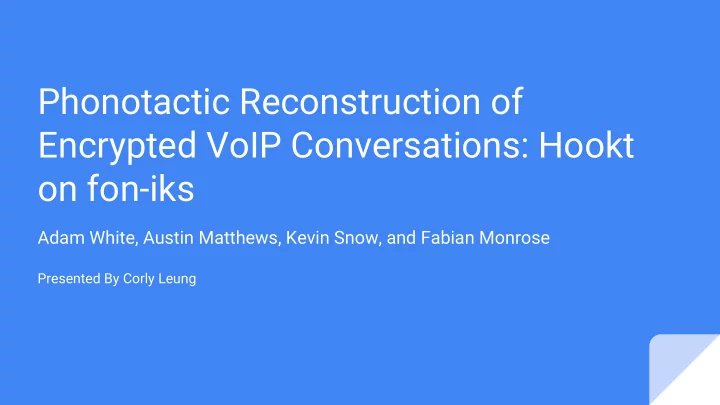

Phonotactic Reconstruction of Encrypted VoIP Conversations: Hookt on fon-iks Adam White, Austin Matthews, Kevin Snow, and Fabian Monrose Presented By Corly Leung
Introduction - Google Hangout, Skype, FaceTime - Encrypting VoIP Packets - Variable-Bit-Rate for speech encoding - Length-preserving stream ciphers - Determine language spoken, identity, and presence of known phrases
Background - Phonetic Models of Speech - Individual units of phones - Consonants vs Vowels - Characterize by articulatory processes - Alphabets for representing phones: International Phonetic Alphabet (IPA) - Voice over IP - Audio encoded with an audio codec - Code Excited Linear Prediction - Excitation signal and Shape Signal
Related Works - Traffic Analysis of Encrypted Network - Encrypted VoIP calls to infer language and match to known phrases - Silence suppression to identify speeches
Data and Adversarial Assumptions - TIMIT Acoustic-Phonetic Continuous Speech Corpus - Collection of Speech with time-aligned word and phonetic transcripts - Encoded to Speex encoded - Adversary - Sequence of Packet Lengths for an encrypted VoIP call - Knowledge of the language - Representative example of sequences for each phoneme - Phonetic dictionary
High Level Overview of Approach
Finding the Phoneme Boundaries - Identify which packets represent a portion of speech containing boundary between phonemes. - Maximum entropy modeling by maximizing p(w|v) - Evaluation: Cross Validation with about 0.85 accuracy for n=1 - n frames within boundary
Classifying the Phonemes - Classification problem of various phonemes - Context dependent - Maximum entropy modeling: model only parameters of interest - Context independent - Profile hidden Markov modeling: model entire distribution over examples - Bayesian inference to update posterior given by maximum entropy classifier with evidence by HMM - Enhancing Classification using Language Modeling - Evaluation: 77% context dependent, 67% context independent vs 69% human
Segmenting Phoneme Streams Into Words - Identify likely word boundaries - Insert potential word breaks into sequence of phonemes - Pronunciation dictionary to find valid word matches - Evaluation: Precision 73% and Recall 85%
Identifying Words via Phonetic Edit Distance - Convert Subsequences of Phonemes into English Words - Phonetically based alignment method - Distance between two vowels/ consonants by rounding, backness, height or voice, manner, and place of articulation - Phonetic distance between sequence and each pronunciation in dictionary - Homophones (eight vs ate) - Word and part of speech model
Overall Evaluation - Speaker independent model - Content-dependent - Multiple utterance of particular sentence - Scoring around 0.67 and 0.9 with 0.5 being understandable - Content-independent - All TIMIT utterances - 0.45 average
Measuring Confidence - Close pronunciation matches are more likely to be correct than distant matches - Mean of probability estimates of each word in hypothesized transcript - Forgoing less confidence words
Mitigations - Varying frame based per packet - Packets are observed in correct order - Relatively large block sizes - Constant bit-rate codecs - Drop or packets
Discussion - What are the key contributions of the paper? - How practical is the attack? - Are the mitigations sufficient?
Recommend
More recommend